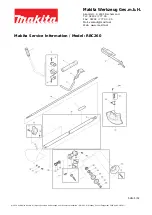
UPPER TRIPLE CLAMP SIZING – DORADO DH
To fit a variety of bike head tube sizes, there are two distinct upper
triple clamps. The flat upper triple clamp is the small size and fits
head tubes between 130 mm and 160 mm in length. The drop upper
triple clamp is the large size and fits head tubes between 155 mm
and 185 mm in length. Both clamps must fully engage the aluminum
bulges on the outer tubes without extending beyond the small taper
line with the upper and lower clamps. All triple clamp bolts must be
torqued to 60–75 in.-lbs. (7.3–8.5 Nm).
HEX AXLE INSTALLATION
The hex axle used on DORADO forks is unique in that it allows
the legs to be locked together once the pinch bolts have been tight-
ened. To install the hex axle, simply slip the axle into the dropout,
small axle hex side first into the large dropout hex. Thread in the set
bolt into the small hex side and snug slightly. Push the fork up and
down a few times to center the axle and hub and then tighten all
pinch bolts to 40–60 in.-lbs. (4.5–6.8 Nm).
ATTACHMENT OF THE BRAKE CABLE
Failure to properly route and securely attach the brake cable to the
fork can cause serious injury or death. Included with the fork is a
small black cable guide that can be attached to the fork guard
depending on how you attach the cable. The best method we’ve
found is to attach the cable so that it runs down the outside of the
left fork leg. Just make sure that you do not attach the cable to the
fork any other place than on the fork guard, as this will cause the
cable to bind and possibly crimp as the fork is compressed. The
cable should be routed through the guides located on the upper car-
bon tubes but should be free to slide.
HANDLEBAR INSTALLATION – DORADO DH
The DORADO DH comes equipped with an integrated handlebar
upper triple clamp system. This provides additional steering stiffness
as well as puts the handlebars straight every time. All handlebar
bolts should be torqued to 50–60 in.-lbs. (5.7–6.8 Nm). All triple
clamp bolts and steerer tube bolts should be torqued to 60–75 in.-
lbs. (7.3–8.5 Nm).
SPRING SETUP – MEASURING SAG
You’ll need a tape measure, a pencil and a piece of paper.
1. Measure the distance from the front axle’s centerline to the bot-
tom of the lower crown without anyone sitting on the bike and
write this distance down. (Remember the exact locations of the
two points because you’ll need to use them later.)
2. Have the rider sit on the bike and measure the distance between
the same two points as in step one. It’s important to be in the
normal riding position (weight centered) with your feet on the
pedals.
3. Subtract the second measurement from the first. The resulting
measurement is the static sag.
SAG MEASUREMENT CHART
FORK MODEL
FORK TRAVEL
SAG
DORADO SC
130 mm
25 to 32 mm
DORADO DH
180 mm
40 to 45 mm
RIDE KITS
Each DORADO fork comes with two medium rate springs installed. In
addition, one firm spring and one soft spring have also been pack-
aged with the fork. Using the recommended sag measurements list-
ed above, adjust the spring stack as necessary. If there is too much
sag, replace a single spring at a time with a firmer one; if too little
sag, replace with a softer one. If additional adjustments are required,
ride kits can be purchased from Answer under the following part
numbers:
MODEL DH
MODEL SC
SPRING RATE
PART NO.
SPRING RATE
PART NO.
Soft
85-4946
Soft
85-4534
Medium
85-4947
Medium
85-4538
Firm
85-4948
Firm
85-4539
Extra Firm
85-4949
DAMPING ADJUSTMENTS –
DORADO FORKS
With DORADO forks, since the fork features an upside-down design,
the damping system is also reversed. As a result, compression
damping adjustment is now located at the bottom of the right leg
and rebound damping is on top of the right leg.
COMPRESSION DAMPING ADJUSTMENT – TPC PLUS
For TPC Plus-equipped DORADO forks, a turn of the knob located on
the bottom of the right leg is all that is needed to adjust compression
damping. Turning the knob clockwise (as you are looking at the fork
from the bottom) increases compression damping, while turning it
counterclockwise decreases compression damping.
REBOUND DAMPING ADJUSTMENT – TPC PLUS
Rebound adjusters on DORADO forks are located on the top of the
right fork leg. Turning the knob clockwise (as you are looking from a
rider’s position) increases rebound damping, while turning it coun-
terclockwise decrease rebound damping.
BEFORE EACH RIDE
IMPORTANT: The DORADO should not be used if any parts
appear to be or are damaged. Contact your local dealer or
Answer Products for replacement parts.
IMPORTANT: Before every ride you should:
1. Ensure that the through-axle is properly adjusted and tight.
2. Wipe the inner legs and clean and check the entire fork for any
obvious damage.
3. Check the headset for proper adjustment.
4. Ensure that the front brake cable is properly routed and check
brake adjustment.
BREAK-IN
Your new fork is designed to break in during your first few rides
(about 20 hours total riding time). Prior to break-in, you may notice
your fork feels tight and slightly sticky. Following the break-in period,
your fork will feel much smoother and react to bumps much better
than when you first put it on your bike. After 20 hours, you may
want to recheck your compression and rebound to fine tune the fork
completely.
Содержание DORADO DH
Страница 1: ......
























